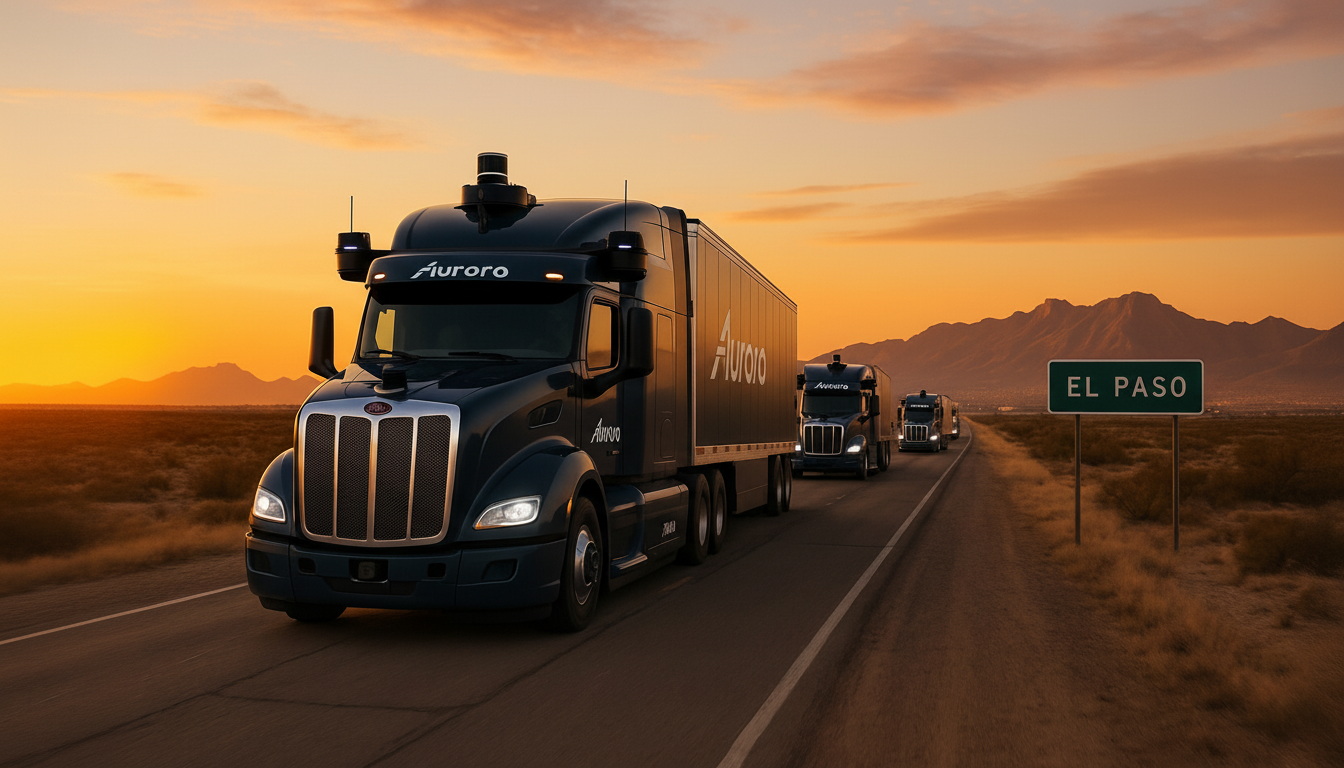Aurora is expanding its robotic freight network with a new 600-mile driverless lane connecting Fort Worth and El Paso, the company’s second route for self-driving trucks and a critical push further along the I-20/I-10 freight corridor.
The expansion is an extension of the company’s first commercial route from Dallas to Houston and comes as the company says it has crossed over 100,000 driverless miles on public roads with five trucks since launching commercial service. Executives presented the Fort Worth–El Paso lane as something of a sweet spot for autonomy: long enough to drive meaningful gains in utilization for carriers and hard enough for human drivers to complete in one shift under hours-of-service rules.

Launch customers on the El Paso lane include Hirschbach Motor Lines and Russell Transport, repeating earlier partnerships with both Hirschbach and Uber Freight on the Houston run, Aurora said. The company has also doubled down on a short-term ambition to extend service west to Phoenix, ultimately sewing together a high-volume Southwest corridor.
Why autonomy matters in the El Paso freight market
El Paso is home to one of the continent’s busiest cross-border trading hubs. The El Paso–Ciudad Juárez region is a major manufacturing and nearshoring supply chain cluster with heavy truck flows that drive national distribution on I-10. According to the Bureau of Transportation Statistics, Mexico has been the No. 1 trade partner for the U.S. since 2023 and in truck crossings during that time, Texas ports of entry led, where predictable, repeatable long-haul lanes suitable for autonomous operations are well suited to this environment.
A carrier needs to overcome operational hurdles to work a 600-mile haul. Even within the 11-hour driving window, dwell times, handoffs and congestion can sometimes push layovers that increase cost and unpredictability. Aurora contends that its driverless design can keep assets in constant motion for longer on those lanes, resulting in more trailer turns and fewer missed delivery windows. The pitch comes as the industry faces a chronic driver shortage; the American Trucking Associations estimates that, if current trends continue, it could face a shortfall of more than 160,000 drivers by 2030.
How the Fort Worth–El Paso autonomous lane will work
Like its Houston service, Aurora is highlighting hub-to-hub independence by dropping the freight off at staffed terminals located near highway interchanges. It minimizes complex maneuvers in urban environments and maximizes highway driving where high-definition maps, redundancy and long-distance sensors can be used more effectively. The company said its autonomous rides are backed by remote monitoring and “rigorous” incident response procedures honed during the period it tested with “safety drivers.”

It is one that carriers employing the El Paso lane are likely to fit into broader networks: human drivers work first- and last-mile moves, including specialized freight like oversized loads, while self-driving tractors traverse long stretches of monotonous highways that can wear out duty cycles over time. That hybrid model is becoming the short-term route to scaling autonomy in freight.
New hardware and the manufacturing scale required
Aurora also shared an update on its next generation of hardware stack, which is built by Fabrinet and being integrated to the Volvo VNL Autonomous through a novel pilot line at Volvo’s New River Valley facility. The company claims the new suite is more robust and high-performing, aiming for about 50% lower overall system cost than the current generation—a key metric for unit economics at scale.
Among the key upgrades: a lidar that can sense objects as far as 1,000 meters—twice the previous range—and new sensor-cleaning systems to keep cameras and more laser-based sensors known as lidar spot-free from dust, rain and road grime common on Southwestern corridors. Aurora intends to produce hundreds of trucks using these components in 2026, before transitioning to a higher volume platform developed with Aumovio (formerly Continental) scheduled for 2027. That collaboration is supposed to underpin the production of tens of thousands of autonomous trucks as demand materializes.
Key milestones to watch as Aurora scales in the Southwest
Regulatory alignment is working in Texas where driverless operations as defined under state law are allowed without a human driver in the cab and federal oversight encircles reporting and safety standards. The next challenge for Aurora is scaling consistency: staying safe as it adds trucks, miles and weather variability across the El Paso route and possibly a Phoenix expansion.
If Aurora can maintain high asset utilization, keep maintenance costs in check with its next-gen hardware and demonstrate reliable service over a longer desert corridor, the Fort Worth–El Paso lane might be an example of interstate autonomy that’s long, repeatable and commercially meaningful. For shippers running cross-border goods and time-sensitive freight around the Southwest, that’s when autonomy starts to sound less like a promise and more like an on-the-ground advantage — as opposed to a pilot program.

